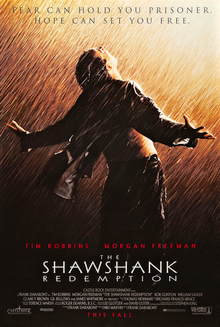Release Year: 1994
Director: Frank Darabont
Cast: Tim Robbins, Morgan Freeman.
Plot: Andrew Dufresne is sent to prison to fulfill a penal servitude for life after he's condemned for the murder of his wife and her lover. After years of imprisonment he gains the trust of the prison headmaster and the respect and admiration of his prison mates, especially Red, the 'one who gets what you want in prison'.
Review: If you're a moviegoer, you'll know that the condemned-man-breaks-free plot is quite common in American cinema, maybe because it's powerful and reaches one of the most beloved topics in film industry: freedom. Anyhow, 'The Shawshank Redemption' is not only a smartly planned leak from prison, it's a real personal journey for its leading characters.
Marvelously cast, Andrew and Red become friends after some time in prison. Freeman's Red, the narrator, quickly feels a secret admiration for him and his quiet behaviour. Many critics said that the fact that Dudresne seems all the time detached from everything didn't contribute to the audience's connection with the film, but I personaly found his performance impressive and raw. Moreover, his character is smart and clever, and responsible for the major plot twist in the film; his escape unfolds so incredibly that the audience is left baffled observing the poster of Raquel Welch. When after crawling for hundreds and hundred of meters of crap he finally reaches the water and liberates himself, any detached member of the audience must feel connected with the character, in a powerfully emotional scene, a symbol of his success over the tyranny imposed by the prison's headmaster, a corrupt character whose moment to pay arrives later in the movie thanks to the visionary mind of Dufresne.
As the marvelous score sounds, Dufrasne escapes from prison in this beautiful and wonderful scene
The other main topic in the film is the belonging to the prison, the fact of being 'institutionalized'. When Brooks is set free almost fifty years after he was condemned, he must return to an unknown and changed society (he entered at the beginning of the 20th century and goes out in 1954) where he feels he has no place or recognition (unlike in prison, where he was considered an educated man) and ultimately kills himself, but hanging from a beam, after writing 'Brooks was here'. The same situation happens when after years of questionnaires they let Red go. He starts to understand Brooks as he feels too old for a society where he no longer belongs and, the same way that he suffered for the possibility of Andrew killing himself for so many years of unfair imprisonment, the audience starts fearing the worst. But his time, Drufrasne is there to help him; he visits the location that he indicated him once to go if he ever was freed and there he finds (as Andrew had planned) money and a letter to join his friend in Zihuatanejo, a Mexican Pacific coastal town, which he ultimately does, writing 'So was Red' next to the message left by Brooks and violating his parole. At the end, both friends reunite as they hug each other in an emotional ending.

The friendships of Andrew, connected in prison through the years, is what leads the movie from its beginning to the very end
Marvelously cast, Andrew and Red become friends after some time in prison. Freeman's Red, the narrator, quickly feels a secret admiration for him and his quiet behaviour. Many critics said that the fact that Dudresne seems all the time detached from everything didn't contribute to the audience's connection with the film, but I personaly found his performance impressive and raw. Moreover, his character is smart and clever, and responsible for the major plot twist in the film; his escape unfolds so incredibly that the audience is left baffled observing the poster of Raquel Welch. When after crawling for hundreds and hundred of meters of crap he finally reaches the water and liberates himself, any detached member of the audience must feel connected with the character, in a powerfully emotional scene, a symbol of his success over the tyranny imposed by the prison's headmaster, a corrupt character whose moment to pay arrives later in the movie thanks to the visionary mind of Dufresne.
As the marvelous score sounds, Dufrasne escapes from prison in this beautiful and wonderful scene
The other main topic in the film is the belonging to the prison, the fact of being 'institutionalized'. When Brooks is set free almost fifty years after he was condemned, he must return to an unknown and changed society (he entered at the beginning of the 20th century and goes out in 1954) where he feels he has no place or recognition (unlike in prison, where he was considered an educated man) and ultimately kills himself, but hanging from a beam, after writing 'Brooks was here'. The same situation happens when after years of questionnaires they let Red go. He starts to understand Brooks as he feels too old for a society where he no longer belongs and, the same way that he suffered for the possibility of Andrew killing himself for so many years of unfair imprisonment, the audience starts fearing the worst. But his time, Drufrasne is there to help him; he visits the location that he indicated him once to go if he ever was freed and there he finds (as Andrew had planned) money and a letter to join his friend in Zihuatanejo, a Mexican Pacific coastal town, which he ultimately does, writing 'So was Red' next to the message left by Brooks and violating his parole. At the end, both friends reunite as they hug each other in an emotional ending.

The friendships of Andrew, connected in prison through the years, is what leads the movie from its beginning to the very end
.jpg)
.jpg)


No hay comentarios:
Publicar un comentario